Andreas Jakobsson
Boundary-Informed Sound Field Reconstruction
Jun 16, 2025Abstract:We consider the problem of reconstructing the sound field in a room using prior information of the boundary geometry, represented as a point cloud. In general, when no boundary information is available, an accurate sound field reconstruction over a large spatial region and at high frequencies requires numerous microphone measurements. On the other hand, if all geometrical and acoustical aspects of the boundaries are known, the sound field could, in theory, be simulated without any measurements. In this work, we address the intermediate case, where only partial or uncertain boundary information is available. This setting is similar to one studied in virtual reality applications, where the goal is to create a perceptually convincing audio experience. In this work, we focus on spatial sound control applications, which in contrast require an accurate sound field reconstruction. Therefore, we formulate the problem within a linear Bayesian framework, incorporating a boundary-informed prior derived from impedance boundary conditions. The formulation allows for joint optimization of the unknown hyperparameters, including the noise and signal variances and the impedance boundary conditions. Using numerical experiments, we show that incorporating the boundary-informed prior significantly enhances the reconstruction, notably even when only a few hundreds of boundary points are available or when the boundary positions are calibrated with an uncertainty up to 1 dm.
Sound Field Estimation Using Deep Kernel Learning Regularized by the Wave Equation
Jul 05, 2024Abstract:In this work, we introduce a spatio-temporal kernel for Gaussian process (GP) regression-based sound field estimation. Notably, GPs have the attractive property that the sound field is a linear function of the measurements, allowing the field to be estimated efficiently from distributed microphone measurements. However, to ensure analytical tractability, most existing kernels for sound field estimation have been formulated in the frequency domain, formed independently for each frequency. To address the analytical intractability of spatio-temporal kernels, we here propose to instead learn the kernel directly from data by the means of deep kernel learning. Furthermore, to improve the generalization of the deep kernel, we propose a method for regularizing the learning process using the wave equation. The representational advantages of the deep kernel and the improved generalization obtained by using the wave equation regularization are illustrated using numerical simulations.
Room Impulse Response Estimation using Optimal Transport: Simulation-Informed Inference
Mar 06, 2024Abstract:The ability to accurately estimate room impulse responses (RIRs) is integral to many applications of spatial audio processing. Regrettably, estimating the RIR using ambient signals, such as speech or music, remains a challenging problem due to, e.g., low signal-to-noise ratios, finite sample lengths, and poor spectral excitation. Commonly, in order to improve the conditioning of the estimation problem, priors are placed on the amplitudes of the RIR. Although serving as a regularizer, this type of prior is generally not useful when only approximate knowledge of the delay structure is available, which, for example, is the case when the prior is a simulated RIR from an approximation of the room geometry. In this work, we target the delay structure itself, constructing a prior based on the concept of optimal transport. As illustrated using both simulated and measured data, the resulting method is able to beneficially incorporate information even from simple simulation models, displaying considerable robustness to perturbations in the assumed room dimensions and its temperature.
Learning an Interpretable End-to-End Network for Real-Time Acoustic Beamforming
Jun 19, 2023Abstract:Recently, many forms of audio industrial applications, such as sound monitoring and source localization, have begun exploiting smart multi-modal devices equipped with a microphone array. Regrettably, model-based methods are often difficult to employ for such devices due to their high computational complexity, as well as the difficulty of appropriately selecting the user-determined parameters. As an alternative, one may use deep network-based methods, but these are often difficult to generalize, nor can they generate the desired beamforming map directly. In this paper, a computationally efficient acoustic beamforming algorithm is proposed, which may be unrolled to form a model-based deep learning network for real-time imaging, here termed the DAMAS-FISTA-Net. By exploiting the natural structure of an acoustic beamformer, the proposed network inherits the physical knowledge of the acoustic system, and thus learns the underlying physical properties of the propagation. As a result, all the network parameters may be learned end-to-end, guided by a model-based prior using back-propagation. Notably, the proposed network enables an excellent interpretability and the ability of being able to process the raw data directly. Extensive numerical experiments using both simulated and real-world data illustrate the preferable performance of the DAMAS-FISTA-Net as compared to alternative approaches.
Coherent FDA Receiver and Joint Range-Space-Time Processing
Jun 01, 2023Abstract:When a target is masked by mainlobe clutter with the same Doppler frequency, it is difficult for conventional airborne radars to determine whether a target is present in a given observation using regular space-time adaptive processing techniques. Different from phased-array and multiple-input multiple-output (MIMO) arrays, frequency diverse arrays (FDAs) employ frequency offsets across the array elements, delivering additional range-controllable degrees of freedom, potentially enabling suppression for this kind of clutter. However, the reception of coherent FDA systems employing small frequency offsets and achieving high transmit gain can be further improved. To this end, this work proposes an coherent airborne FDA radar receiver that explores the orthogonality of echo signals in the Doppler domain, allowing a joint space-time processing module to be deployed to separate the aliased returns. The resulting range-space-time adaptive processing allows for a preferable detection performance for coherent airborne FDA radars as compared to current alternative techniques.
Designing FDA Radars Robust to Contaminated Shared Spectra
Apr 14, 2022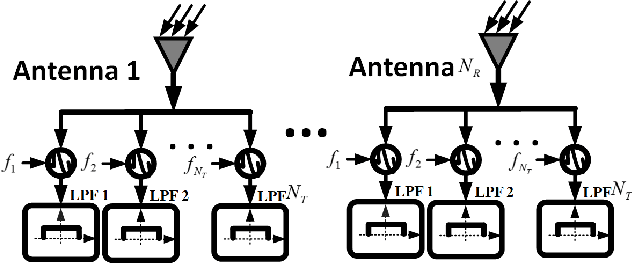
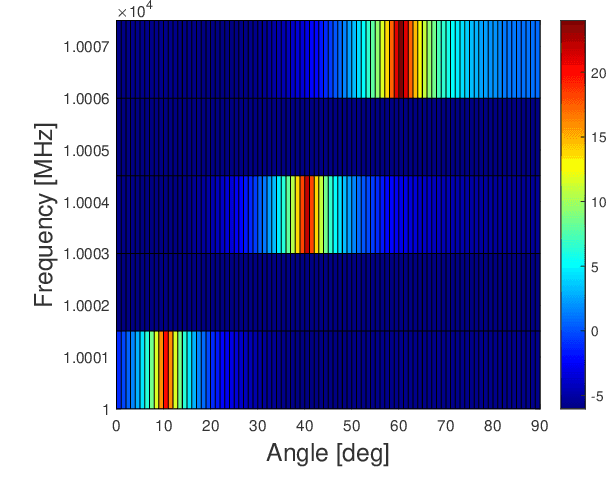
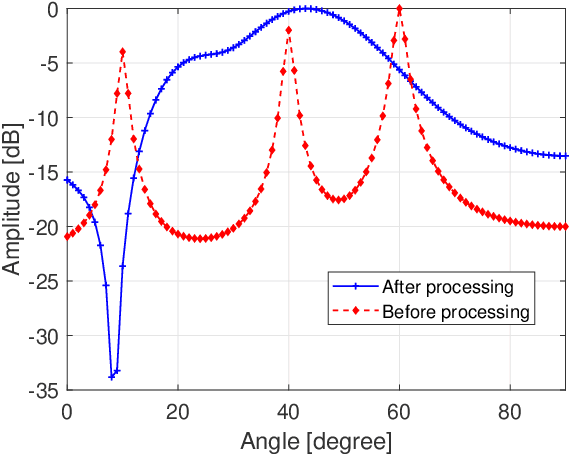

Abstract:This paper considers the problem of jointly designing the transmit waveforms and weights for a frequency diverse array (FDA) in a spectrally congested environment in which unintentional spectral interferences exist. Exploiting the properties of the interference signal induced by the processing of the multi-channel mixing and low-pass filtering FDA receiver, the interference covariance matrix structure is derived. With this, the receive weights are formed using the minimum variance distortionless response (MVDR) method for interference cancellation. Owing to the fact that the resulting output signal-to-interference-plus-noise ratio (SINR) is a function of the transmit waveforms and weights, as well as due to the ever-greater competition for the finite available spectrum, a joint design scheme for the FDA transmit weights and the spectrally compatible waveforms is proposed to efficiently use the available spectrum while maintaining a sufficient receive SINR. The performance of the proposed technique is verified using numerical simulations in terms of the achievable SINR, spectral compatiblity, as well as several aspects of the synthesized waveforms.
Waveform Optimization with SINR Criteria for FDA Radar in the Presence of Signal-Dependent Mainlobe Interference
Apr 14, 2022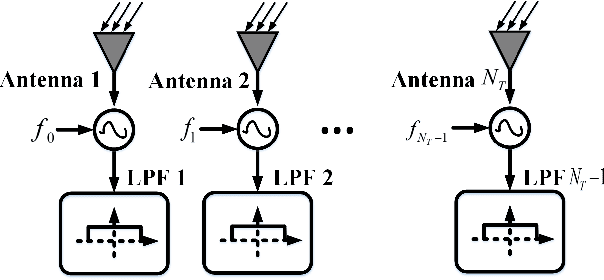
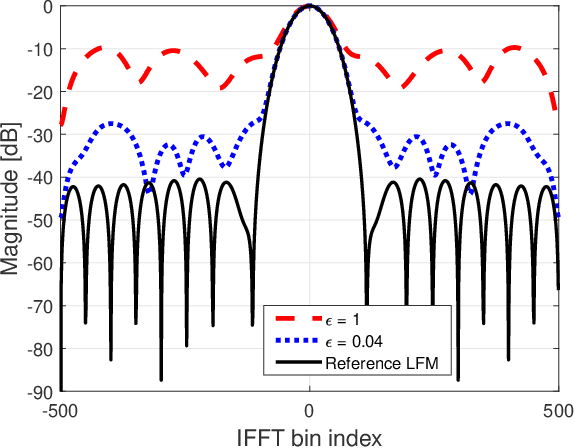


Abstract:In this paper, we focus on the design of the transmit waveforms of a frequency diverse array (FDA) in order to improve the output signal-to-interference-plus-noise ratio (SINR) in the presence of signal-dependent mainlobe interference. Since the classical multi-carrier matched filtering-based FDA receiver cannot effectively utilize the waveform diversity of FDA, a novel FDA receiver framework based on multi-channel mixing and low-pass filtering is developed to keep the separation of the transmit waveform at the receiver side, while preserving the FDA range-controllable degrees of freedom. Furthermore, a range-angle minimum variance distortionless response beamforming technique is introduced to synthesize receiver filter weights with the ability to suppress a possible signal-dependent mainlobe interference. The resulting FDA transmit waveform design problem is initially formulated as an optimization problem consisting of a non-convex objective function and multiple non-convex constraints. To efficiently slove this, we introduce two algorithms, one based on a signal relaxation technique, and the other based on the majorization minimization technique. The preferable performance of the proposed multi-channel low-pass filtering receiver and the optimized transmit waveforms is illustrated using numerical simulations, indicating that the resulting FDA system is not only able to effectively suppress mainlobe interference, but also to yield estimates with a higher SINR than the FDA system without waveform optimization.
An efficient solver for designing optimal sampling schemes
Nov 10, 2021Abstract:In this short paper, we describe an efficient numerical solver for the optimal sampling problem considered in "Designing Sampling Schemes for Multi-Dimensional Data". An implementation may be found on https://www.maths.lu.se/staff/andreas-jakobsson/publications/.
Determining Joint Periodicities in Multi-time Data With Sampling Uncertainties
Oct 05, 2021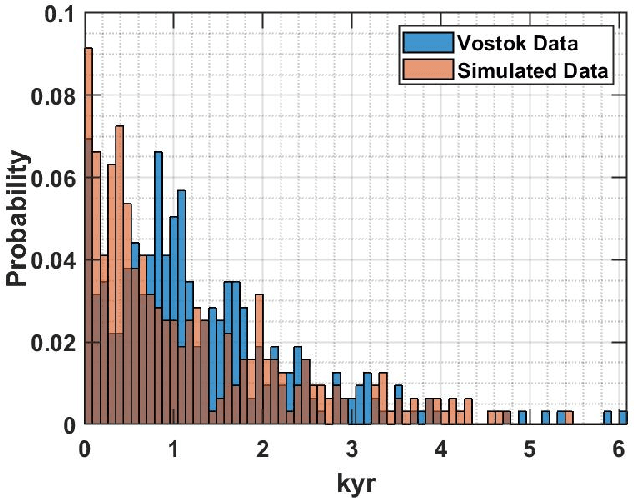
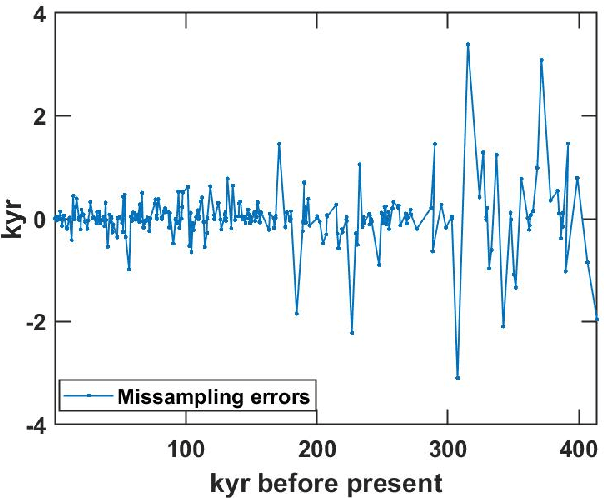
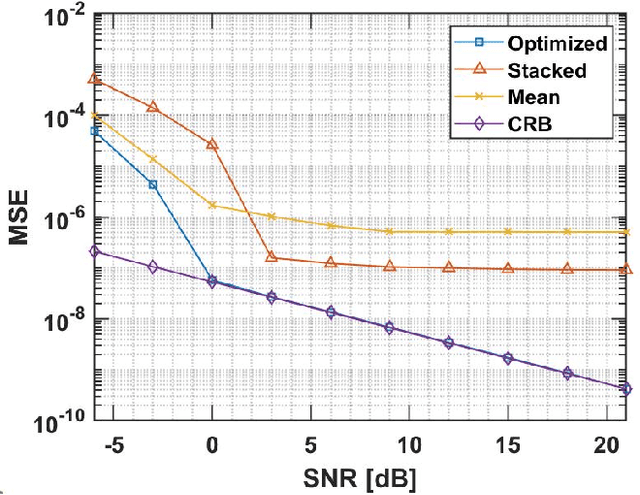
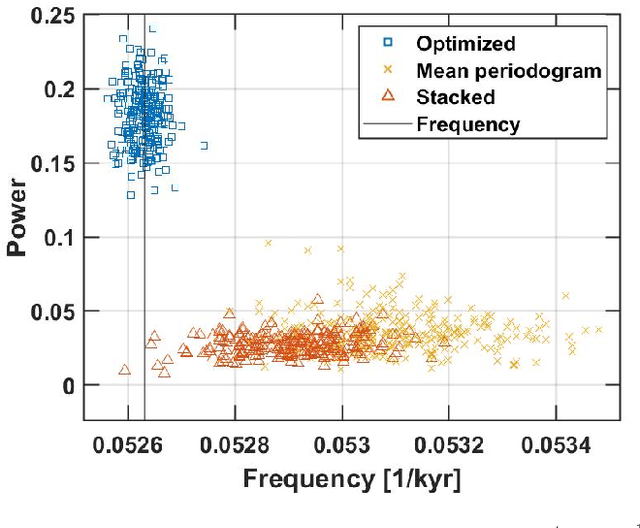
Abstract:In this work, we introduce a novel approach for determining a joint sparse spectrum from several non-uniformly sampled data sets, where each data set is assumed to have its own, possibly disjoint, and only partially known, sampling times. The potential of the proposed approach is illustrated using a spectral estimation problem in paleoclimatology. In this problem, each data point derives from a separate ice core measurement, resulting in that even though all measurements reflect the same periodicities, the sampling times and phases differ among the data sets. In addition, sampling times are only approximately known. The resulting joint estimate exploiting all available data is formulated using a sparse reconstruction framework allowing for a reliable and robust estimate of the underlying periodicities. The corresponding misspecified Cram\'er-Rao lower bound, accounting for the expected sampling uncertainties, is derived and the proposed method is shown to attain the resulting bound when the signal to noise ratio is sufficiently high. The performance of the proposed method is illustrated as compared to other commonly used approaches using both simulated and measured ice core data sets.
 Add to Chrome
Add to Chrome Add to Firefox
Add to Firefox Add to Edge
Add to Edge